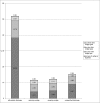Period Prevalence of Dizziness and Vertigo in Adolescents
- PMID: 26361225
- PMCID: PMC4567278
- DOI: 10.1371/journal.pone.0136512
Period Prevalence of Dizziness and Vertigo in Adolescents
Abstract
Objectives: To assess the period prevalence and severity of dizziness and vertigo in adolescents.
Methods: In 1661 students in 8th-10th grade in twelve grammar schools in Munich, Germany information on vertigo/dizziness was assessed by a questionnaire in the class room setting. Three month prevalence of dizziness/vertigo was estimated; symptoms were categorized as orthostatic dizziness, spinning vertigo, swaying vertigo or unspecified dizziness. Duration of symptoms and impact on daily life activities were assessed.
Results: 72.0% (95%-CI = [69.8-74.2]; N = 1196) of the students (mean age 14.5±1.1) reported to suffer from at least one episode of dizziness or vertigo in the last three months. Most adolescents ticked to have symptoms of orthostatic dizziness (52.0%, 95%-CI = [49.5-54.4], N = 863). The period prevalence for the other types of vertigo were spinning vertigo: 11.6%, 95%-CI = [10.1-13.3], N = 193; swaying vertigo: 12.2%, 95%-CI = [10.6-13.8], N = 202; and unspecified dizziness: 15.2%, 95%-CI = [13.5-17.1], N = 253. About 50% of students with spinning vertigo and swaying vertigo also report to have orthostatic dizziness. Most vertigo/dizziness types were confined to less than one minute on average. The proportion of students with any dizziness/vertigo accounting for failure attending school, leisure activities or obliging them to stay in bed were more pronounced for spinning or swaying vertigo.
Conclusion: Dizziness and vertigo in grammar school students appear to be as common as in adults. In face of the high period prevalence and clinical relevance of dizziness/vertigo in adolescents there is a need for prevention strategies. Risk factors for dizziness/vertigo need to be assessed to allow for conception of an intervention programme.
Conflict of interest statement
Figures
References
-
- Neuhauser HK, von Brevern M, Radtke A, Lezius F, Feldmann M, et al. (2005) Epidemiology of vestibular vertigo: a neurotologic survey of the general population. Neurology 65: 898–904. - PubMed
-
- Kroenke K, Price RK (1993) Symptoms in the community. Prevalence, classification, and psychiatric comorbidity. Arch Intern Med 153: 2474–2480. - PubMed
Publication types
MeSH terms
LinkOut - more resources
Full Text Sources
Other Literature Sources
Medical




